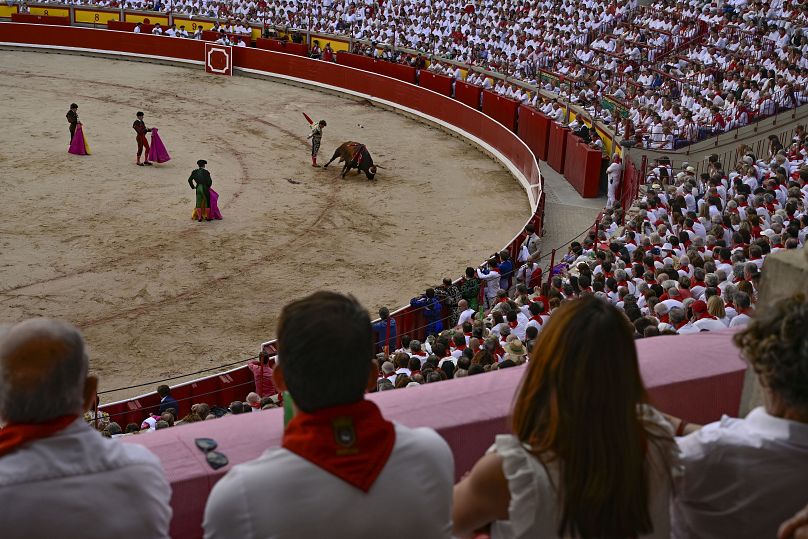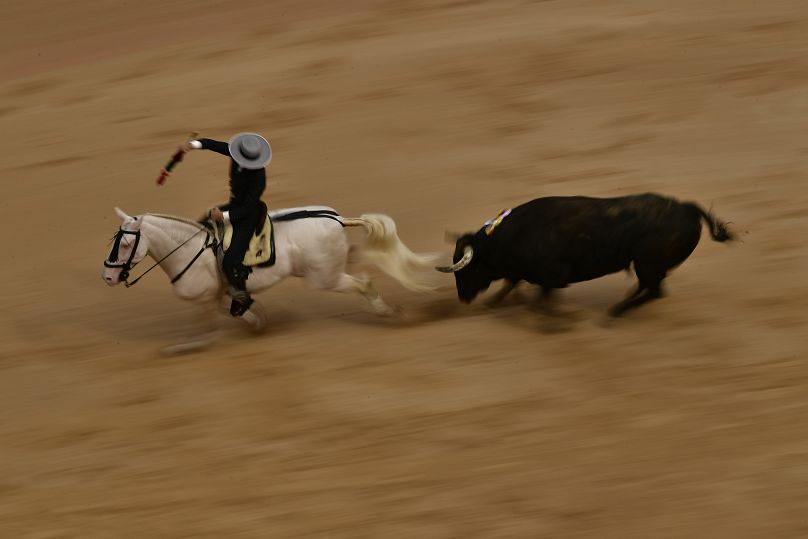San Fermín, the world-famous bull-running festival, returned on Thursday after two years of closure for the pandemic.
Fighting bulls charge down the narrow winding streets of Pamplona, Spain as thousands of runners take their lives in their hands.
San Fermín, the world-famous bull-running festival, finally returned on Thursday after two years of closure for the pandemic.
The 848-metre route to the city’s bullring, down which the bulls run every morning for eight days during the festival, has become a mecca for anyone brave – or foolish - enough to put themselves at the mercy of the half-tonne animals.
At the end of each day, the bulls involved in the morning’s run are used in a series of bullfights and almost always end up on the wrong end of the matador’s espada –- Spanish for sword.
The fiesta also gives itself over to a week of eating, drinking and dancing.
No stranger to controversy, San Fermín always faces intense criticism from animal rights groups who launch imaginative protests before the chupinazo firework marks the start of festivities.
Yet even supporters of the bloody spectacle admit that though Pamplona is a celebration of bullfighting, the reality is that across Spain it is in decline amid a growing animal rights movement and a younger generation which has other interests.
Spain’s culture ministry compiles detailed reports about the number of bullfights which are held each year as the spectacle is regarded as part of the nation’s cultural life, rather like theatre, cinema or literature.
The number of bullfights fell from 3,651 in 2007 to 1,425 in 2019, the last year before the pandemic when normal figures were available. During the first year of the pandemic in 2020, only 129 fights were held.
Only 6% of the population attended bullfights between 2018-2019, the last year when data was collected on how many people attended the fiesta nacional (the national fiesta as it is known).
Some Spaniards regard bullfighting as part of the nation’s cultural life while others believe it is cruel or do not have any interest in going to see los toros as the spectacle is known.
Pedro Gutierrez Moya, a famous bullfighter known as El Niño de la Capea who now breeds fighting bulls, became a matador because it was a way to get food for his desperately poor family.
When he was growing up in the 1960s, the bulls were used for meat after they were killed in the ring and sold off.
He insisted fighting bulls received much better treatment than most animals bred by man as they spend four years roaming the fields before they meet their end in the ring.
“It is the best form of conservation of animals. The bulls get much better treatment than cows brought up for meat,” he told Euronews.
“The biggest problem is the rise of animal rights groups and a government which is not on our side. They do not want to do anything to help us.”
Last year, Spain’s left-wing coalition government granted one-off €400 grants to young people aged 18-24 to be spent on cultural activities like going to the theatre, cinema or visiting art museums. It was intended to help an industry ravaged by the pandemic.
However, the measure caused controversy because it did not include bullfighting, a slight which the Fundación del Toro de La Lidia, the organisation which represents the industry, objected to.
“This exclusion of bullfighting is illegal because it is exactly contrary to promoting which the government is supposed to do with cultural activities,” said the organisation in a statement.
The Fundación del Toro de la Lidia was alluding to a law passed in 2013 by a previous conservative government which said that bullfighting was part of the national heritage, effectively preventing any attempts to ban the practice.
Antonio Lorca, bullfighting critic of El País newspaper, Spain’s biggest selling daily, said the bloody sport was ready to return to the fray after a lull of two years when closed rings severely threatened the survival of bullfighting.
“Despite what should be a return, the same problems remain. There is division in bullfighting over how to tackle big problems like a government which is not sympathetic and how to attract the younger generation,” he told Euronews.
“If you go to bullfights, you see that most people are middle-aged or older. We need to find a way to attract younger people or this will become more marginalised.”
Sitting next to me at a bullfight in Pamplona was 13-year-old José, whose mother did not want his real name to be used. As he watched three rejoneadores – matadors who kill the animal while riding a horse – he said he liked the spectacle.
“I am not so keen on the bit where they have to kill the bull though,” he said.
The packed crowd had a few young faces as parents took their children to watch Guillermo Hermoso de Mendoza, one of the rising stars of bullfighting. But most were middle-aged or elderly.
Aida Gascón, president of AnimaNaturalis, an animal rights group, took part in a demonstration in Pamplona in which protesters dressed as 46 dinosaurs raced along the track that the bulls take through Pamplona.
The number represents the bulls used to run during San Fermín, who later faced matadors in the ring.
“The idea is that bullfighting is prehistoric, and we wanted to show this to the world in our demonstration. It is supposed to be light-hearted,” Gascón told Euronews.
She said she hoped the decline of bullfighting would continue despite the hopes of aficionados or supporters that it would stage a comeback after the pandemic.
“We expect that this year we will see that there are fewer bullfights than before the pandemic as the decline continues in this cruel activity,” she said.
A survey published in January by the BBVA Foundation, an organisation associated with Spain’s second-largest bank, found almost 70 per cent of Spaniards polled rejected the use of animals in bullfights, while 23 per cent backed it.
Eight out of ten people said they thought animals should be respected in the survey of 2,000 people.
Gascón hopes her organisation can raise a petition to overturn the 2013 law which declared bullfighting part of the national heritage.
She said AnimaNaturalis would try to force politicians to overturn the law which protects bullfighting.
In reality, only the far-left Unidas Podemos party, the junior coalition partner in the present government, has indicated it favoured banning bullfighting. The Socialists have shown no support for a ban, perhaps realising it would lose them votes.
The opposition conservative People’s Party is against any measures against bullfighting and the far-right Vox party, which is the third-largest in the Spanish parliament with 52 seats, has made defending the spectacle a manifesto promise.













